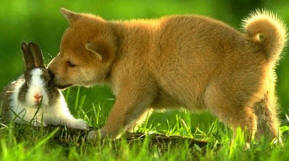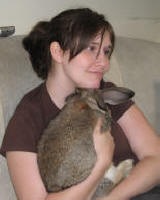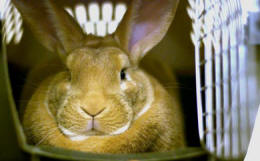|
Prevention is Easier than Correction
 Like everything else in life, it is easier to prevent problems between your new rabbit and your household Pets than it is to convince them to get along after a bad experience. Like everything else in life, it is easier to prevent problems between your new rabbit and your household Pets than it is to convince them to get along after a bad experience.
The best time to introduce your rabbit to your household Pets is when they are hungry.
The younger Pets are when they meet each other for the first time, the easier it usually goes. Cats and dogs accept other species more easily when they are in their critical socialization developmental period - for cats before ten weeks of age and for dogs before 16 weeks of age.
|
In difficult severe cases, the rabbit-household Pets peace process might takes weeks or longer. Trying to push it too quickly will cause the problem to worsen, instead of improve. |
Brokering An Agreement
Ask yourself this question, "What can I do to help my household Pets to perceive my rabbit as the one who makes my life better?"
Think about all the ways you can help your household Pets relax when around your rabbit and to accept your rabbit as an upgrade to the household. And, remember that bribery works!
1. Calm introductions -
Allow your Pet to see you set up your rabbit's pen and safe room. Be jolly and happy talking to your Pets about the rabbit's upcoming arrival. Give your Pet treats for calm behavior in the new room and when you are introducing your Pets to the new scents without the rabbit.
2. Safe room - Allow your rabbit to adjust to the new pen and "safe room" without the potential stress of other Pets outside of the door during their first day home.
3. Keep your rabbit separated
from your household Pets for about a week. Separated means no physical contact or eye contact.
4. Scent introduction. Feed your household Pets on the outside of the rabbit's room door. If your dog or cat becomes aroused, in a jolly, relaxed tone, remove the Pet from the rabbit's door. Do not scold (negative association with rabbit), simply "change the subject". If your dog likes a ball, bounce the ball. Have a treat ready and ask your dog to sit. For cats, have a treat and toy that your cat likes to chase and use the toy (or treat) to move your cat away.
 5. Positive associations.
In addition to sharing meals outside of a door, introduce your rabbit as a new wonderful addition to your home by preparing some REALLY special treats for your household Pets. Use treats to reward relaxed or friendly postures or simply ignoring the scent of your rabbit from under the door. Ideally, ask your Pet to "earn" the treats by following an instruction such as "sit". 5. Positive associations.
In addition to sharing meals outside of a door, introduce your rabbit as a new wonderful addition to your home by preparing some REALLY special treats for your household Pets. Use treats to reward relaxed or friendly postures or simply ignoring the scent of your rabbit from under the door. Ideally, ask your Pet to "earn" the treats by following an instruction such as "sit".
6. Scent transfer. During this isolation time, you want to introduce your rabbit and your household Pets to each other by scent only. First, stroke your rabbit with a washcloth and place it by your dog's food bowl. When your Pet is calm with the scented washcloth, you are ready for the next step. Use the washcloth to stroke your rabbit, then use the same washcloth to stroke your dog. Use another washcloth to stroke your dog, then stroke your rabbit. Be very calm, happy, and relaxed during the cloth stroking.
7. Small safe doses of eye contact. When Pets are relaxed around each other's scent, begin small doses of safe eye contact from a distance. Open the door to the rabbit room with the dog on a tether or on a long-down-stay or in a kennel and cats inside of a kennel (or the rabbit inside of the kennel). Praise and give treats to rabbit and Pets for calm, relaxed behaviors. Stop the eye contact session after one to two minutes or before the first signs of arousal. Your goal is to keep rabbit and other Pets learning to be calm around each other by rewarding good behavior!
8. Two person stroking. When your rabbit and other Pet are relaxed and calm around each other at a distance, then at a closer distance have two people each with a Pet (rabbit and other household Pet) on their laps. With control (do not allow Pet to escape), stroke the Pets in sight of each other.
9. Getting closer. Each day, move a foot closer together for the stroking sessions. Give the Pets treats during the stroking session and praise for calm, relaxed behaviors.
10. Cross petting. When the rabbit and household Pet can be calm during stroking while the people stroking them (and controlling them) are on the same couch, begin by having one person lean over and stroke the other Pet. Take turns doing this "cross petting" to help the rabbit and household Pet become more comfortable around each other.
11. Dog close tethering. Once the rabbit can be in the kennel right next to the dog and they lose interest in sniffing AND the Pet is unconcerned about the rabbit during cross petting then you can begin to hold the rabbit on your lap and have the dog close tethered near you. If you feel confident that you can contain the rabbit (not allow an escape from your lap), you can allow your dog to free roam.
12. Rabbit roaming. The next step is to have the dog close-tethered while you let the rabbit run around. Be RIGHT there with your dog praising all calm responses and able to help your dog accept a friendly approach and greeting by the rabbit. If the dog gets excited and tries to pull on the tether, you are going too fast. Back up to previous steps.
13. Keep supervising and teaching. Be there to interrupt but not physically punish any dog barking or cat stalking of the rabbit. Praise the dog and give treats for ignoring the rabbit or acting relaxed. When you cannot closely supervise, put the rabbit away in the safe room
|
When your rabbit meets your dog or cat, be sure the rabbit or the other Pets are secure and safe from any potential bad experience. You will keep your dog on leash around the rabbit until you are 100% confident in the dog's calm, friendly response to the rabbit. |
Training Tips
Dog controls. Teach your dog to be calm and settled on a mat (leashed indoors until reliable). Give your dog something engaging to chew, if needed, to help teach calm, settled mat behavior. Work with your dog on a reliable "sit-wait" and "down-stay" to help gain verbal control. Avoid any scolding or physical punishment during training. Instead, give your dog something to do to earn praise. Work with your dog just outside the door of your rabbit's room.
Use rewards. Increase the behaviors you want with food treats, favorite toys, and praise.
Positive associations. During these desensitization sessions, give special attention to each household Pet while the rabbit watches. The goal is for each household Pet to think, "all good things seem to happen when the new rabbit is nearby."
Be more clear. To help your Pets really focus on your attention and to think of the new rabbit as a new positive, do not give them any (or very little) attention when around the new rabbit.
|
Interrupt any unwanted behaviors or whenever any Pet becomes too aroused. |
A tired dog is easier to train. Give enough exercise to tire the dog and release pent up energy and stress so that good behavior is easier during rabbit introductions.
Dog head collars. If you think your dog will be difficult to calm around the rabbit, get your dog comfortable wearing a head collar like a "Gentle Leader" in addition to being on leash. If using a head collar for control, you must be sure to use treats to keep your dog's positive association with your new rabbit.
Cat controls. Before your cat meets your rabbit, be sure you can engage your cat in play sessions by dragging a string or other toy designed to get the cat to chase. You want a means of distracting your cat away from your rabbit that is also a positive experience for the cat. Toss in treats during play sessions when your cat pounces on (catches) the prey-like toy. Play with your cat up to 30 minutes daily using prey-like toys to get your cat tired and happy. Exercise relieves a lot of tension and helps the cat exercise normal behaviors. Consider harness and leash training your cat for added control.
 Using kennels. Use a molded plastic portable kennel as a safe place to confine your rabbit or your household dog or cat during introductions. First, help the Pet to become comfortable in the kennel. Feed the Pet inside of it for a week or more. Feed meals not "free choice". Throughout the day, place treats and new toys inside of the kennel to help your Pet to think of the kennel as the provider of good things. Using kennels. Use a molded plastic portable kennel as a safe place to confine your rabbit or your household dog or cat during introductions. First, help the Pet to become comfortable in the kennel. Feed the Pet inside of it for a week or more. Feed meals not "free choice". Throughout the day, place treats and new toys inside of the kennel to help your Pet to think of the kennel as the provider of good things.
Keep your rabbit in a safe (covered) pen or kennel as you watch how your cat responds to the movement of your rabbit. Remove your cat for any focused or aroused responses. |